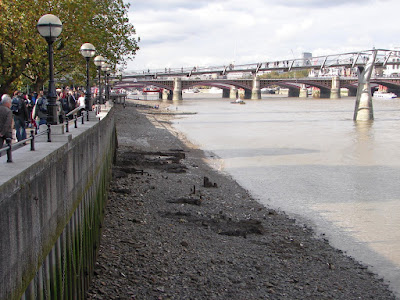Sir Roger made several reflections on the greatness of the British Nation; as, that one Englishman could beat three Frenchmen; that we could never be in danger of Popery so long as we took care of our fleet; that the Thames was the noblest river in Europe...with many other honest prejudices which naturally cleave to the heart of a true Englishman (Joseph Addison, The Spectator, 20 May 1712)
Aside from the petty prejudices of the age, the essayist Joseph Addison was right in espousing the prominence and supremacy of the Thames: its waters were the lifeblood of the burgeoning imperial capital and the flow of the river helped to place London at the centre of the world's economy by the 18th and 19th centuries. Until the 20th century the Thames was a busy thoroughfare of commerce, a provider of sustenance and a receptacle of refuse. While the river is still a busy route, its uses in the 21st century are typically recreational, with a great many tour boats plying up and down its length, and a minority also use it to commute to work from one of the river's many ferry piers. Cargo shipping moved to the Docklands and then further afield when larger vessels and containerisation meant that the Thames was too cramped, and in the past 50 years the worst excesses of industrial pollution has been expunged and marine life has returned to the river that was a biological wasteland in the 1950s. For example, recently scientists have documented the return of seahorses to the waters of the Thames.
Remnants of millennia of river history still lie scattered along the Thames, and it is the task of London's marine archaeologists to record the social history of the city through the artefacts that still emerge from its tidal beaches. Six months ago I went for an impromptu scavenge on the Thames' northern shore near the Millennium Bridge and found a few pottery remains and a mysterious nail. On Saturday I returned to the same part of town for a more organised approach, taking part in one of London Walks' special tours, known as 'Beach-combing on the Thames', led by Fiona, an experienced marine archaeologist.
 A large gathering turned out at Blackfriars station for the walk, and our first stop was on Blackfriars Bridge for a quick familiarisation guide to the area and its history. While we listened, a peculiar drilling rig like a miniaturised North Sea oil station was probing the river bed, working out the best way to extend the station platforms out over the river with the minimum impact. Taking a quick left turn, we walked eastwards along the South Bank to a set of stairs and descended to the exposed low-tide sands, each wearing a single rubber glove to ward off the evil Weil's Disease that can sometimes infect stagnant water along the riverside. We looked like a troupe of treasure-hunting Michael Jacksons.
A large gathering turned out at Blackfriars station for the walk, and our first stop was on Blackfriars Bridge for a quick familiarisation guide to the area and its history. While we listened, a peculiar drilling rig like a miniaturised North Sea oil station was probing the river bed, working out the best way to extend the station platforms out over the river with the minimum impact. Taking a quick left turn, we walked eastwards along the South Bank to a set of stairs and descended to the exposed low-tide sands, each wearing a single rubber glove to ward off the evil Weil's Disease that can sometimes infect stagnant water along the riverside. We looked like a troupe of treasure-hunting Michael Jacksons.Fiona gathered us together every so often to go through our finds and inform us of the various uses to which this section of the river was once put. Several delvers found clay pipe bowls, including one that may have dated to the 1580s. Back then tobacco was so rare that smokers could only purchase it pre-loaded into a cheap clay pipe, and once the pipe had been smoked it was thrown away, often into the river if it was nearby. Certainly there were lots of pipe stem segments around - I had wondered whether they were electrical wire insulation, but it seems they were considerably older than that. The stems are impossible to date, but I have a small segment and I like to think it's from the 16th century rather than the 19th, although I have no way of knowing if I'm anywhere near right!
I found more porcelain fragments, shards of heavy brown pottery, and some iron nails from the shipbuilding industry that occupied much of the riverbank for centuries, but nothing particularly exciting. However, I did manage to ask Fiona about my mystery nail. She had pointed out that the area I'd found it in was known as Alfred's Docks, having been established by Alfred the Great in the 9th century. Apparently my find wasn't a nail - it was more likely the blade of a screwdriver or file. Again, there's no way of knowing if it's of medieval origin without expensive tests, and given the volume of shipbuilding on the Thames it's probably more likely to be Victorian than centuries old, but at least now I can daydream of some medieval shipwright cursing as his prize instrument spills over the side of a half-finished boat into the shallow muddy waters of the river, only for it to be exposed in the tidal flow centuries later so I could find it. It's a nice thought.
(Below, the area we examined. The remains of wooden pilings are what's left of large Thames barge beds where the flat-bottomed cargo boats used to beach)





